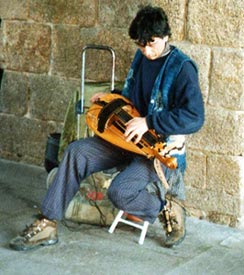 |
 |
 |
|
|||

Music
on Spain's Silver Route
When ancient Romans were busy building the Silver Route -- the north/south thoroughfare on which they carried their Spanish plunder home to Rome -- I doubt they ever came across something like this on the streets of Oviedo: women in lace head scarves, criss-crossed shawls and long, bright skirts; men in knee britches, pointy caps and jackets with long, dangling sleeves. All of them playing drums and gaitas, Spanish bagpipes. Even in these days of MTV and MP3s, Spanish people of all ages still take an interest in their regional music. Oviedo is the capital of Asturias, the northern province where the Silver Route begins. Northern Spain is Celtic Spain, so gaitas are everywhere. As the Banda Gaites Xacara drifted off, a cannon announced the start of a festival -- and the next musical encounter. (sound) cannon: <boom!> Never mind that, according to our guide, the "cider of the last year" tastes exactly like the cider of every other year. Asturias is the hard cider capital of Spain, so uncorking the new "vintage" is just an excuse for a street festival, at which much cider is consumed -- and at which much music is played. This time, it accompanied dancers performing a jota. The jota is a favorite Spanish dance -- every part of the country has its own variant. I'd studied the jota, even delivered a semi-authoritative lecture on the jota, but I have to confess, this was the first time I'd actually seen people dance a jota. It was great. So, I was delighted when the next day, our new guide Miguel started singing jotas over lunch. Since he'd apparently left his castanets in his other pants, he grabbed his accompaniment right off the table. (sound) Miguel playing jota with spoons The spoons were such a big hit that Miguel ordered a bottle of anisette to demonstrate what he called "another folk instrument, handmade." Miguel: "Por el puente de aranda se tiró, se tiró; se tiró el tio juanillo, pero no se mató. Pero no se mató, pero no se mató, por el puente de aranda se tiró, se tiró. Another fix for my developing jota habit. Miguel told us the there'd be more jotas to look forward to the next day, a fiesta in Castilla y León. Sure enough, under an arch in Salamanca... (sound) Salamanca flute/drum/castanets It was Miguel's anisette bottle jota! Only this time, the folk instruments weren't handmade. Lest you think it was all jotas, all the time, I should say that I also found non-native music on the streets of Spain. An African drummer, Russian balalaikas, and a suit-clad trio of guys who learned the Roumanian Rhapsody #1 at their mother's knee. Even non-human musicians got into the act. A Spanish singer named Mauricio may have had trouble tuning his guitar, but he and his canine companion would have no trouble landing a spot on stupid pet tricks. (sound) dog singing Come to think of it, the dog isn't really in tune, either. After the Silver Route, I took a side trip to Santiago de Compostela. (sound) music of the hurdy-gurdy 
The hurdy-gurdy is a really old, really odd string instrument that's really hard to describe. Turn the crank, and a wheel rubs against the strings to create that drone you hear; then, push the keys and the strings play melodies. If you're not a hurdy-gurdy nut like me, your idea of a good time may not be hanging around under an arch listening. Then again, if Santiago is putting on its usual weather display, you may find yourself under an arch, like it or not. 'Enry 'iggins 'ad it all wrong about where the rain in Spain stays. When the skies cleared, I found one last folk group in the park. I don't know if they were playing jotas, but I do know it was hard to keep my feet still. A happy crowd of parents and grandparents held toddlers' hands as they bobbed in time to the music. Add the lush trees, blazing azaleas and deepening dusk, and it made for an enchanted hour. The Silver Route includes some of Spain's most beautiful cathedrals, best-kept Roman ruins, and its oldest university -- I came back from this trip with four rolls of pictures. But if I really want to be transported back to a particular plaza, restaurant or park, it's the music of Spain that does it for me. For The Savvy Traveler, I'm Naomi Lewin. |
|
Search
Savvy Traveler
|
|